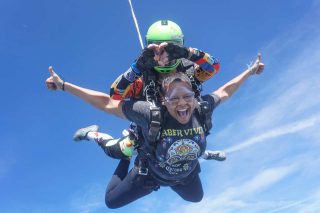Top 3 Tandem Skydiving Landing Tips
Tandem Skydiving
3 years ago
So you’ve decided to do a tandem skydive! Congratulations!!! You are going to love it. And WE love that you’re here to learn how to be the best tandem student ever. Here’s the thing – while you will get the training you need on the day of your jump, learning a little in advance will go a long way.

Parachute Landing Basics
Parachute landings today are much different than they once were. While initial thoughts of parachutes may conjure up images of huge round bunches of silk in the sky (think old school or military parachutes), the rectangular ram-air parachutes of today are an entirely different story.
Rather than plummeting to the ground and having to perform a parachute landing fall (PLF) with every jump, the “square” parachutes of today actually glide and propel you forward. This means that the canopy pilot can choose where to land. And, better yet: on landing, you won’t plop down hard. In fact, in most cases, skydiving landings are pretty graceful.
Tandem Skydiving Landing Tips
As you get ready to take the big leap on the day of your reservation, take a gander at our top three tandem skydiving tips that will help give you the best chances of landing smoothly and gracefully.
Tip 1: Listen to Your Instructor
Your tandem instructor is in charge of every part of your skydive — from gearing up and jumping to flying you down and landing. Why is that? Well, it’s because they’re the experienced ones on the jump, of course!
In fact, by guidelines established by the United States Parachute Association (USPA) your tandem instructor has to have at least 500 jumps (while many have thousands or even tens of thousands). Not only that, but becoming an instructor means that they have passed all the training and requirements to become a true professional in the sky.
At times, it can be easy to get carried away or difficult to relinquish control (you know who you are!), but when it comes down to it, you simply have to surrender on a tandem jump. During all parts of the skydive, it is important to listen to your instructor and follow their directions.

Tip 2: Lift Your Legs
Almost all tandem landings require that the tandem student lifts their legs immediately before landing. It is most common for a tandem pair to do a “butt slide” landing that is … well, it’s exactly how it sounds. Your parachute will be gliding forward, your instructor will slow the speed by flaring (pulling down on the toggles of the parachute), and you and your instructor will slide in gently on your rear ends.
On some occasions (usually when the wind conditions are fairly brisk), the tandem pair will do a stand-up landing, but even in that case, as the tandem student, you should remember to LIFT YOUR LEGS right out in front of you. The only exception to this would be if your instructor specifically tells you to do something different (remember, they’re the professionals in charge and we do what they say).
Lifting your legs is seriously THE proven method to prevent you from suffering an injury on landing (like a broken foot, leg, or ankle – yikes!). The vast majority of all tandem injuries come from failing to follow this instruction.
Tip 3: Prepare in Advance
By reading this article, you’re already preparing for your skydiving landing — kudos! But if you don’t remember the ins and outs of what you learn here, don’t fret. On the day of the jump, you can prepare for your skydiving landing before you even board the aircraft!
Upon arriving at the dropzone on the day of your jump, you’ll check in at the Student Training Center (STC). Once several other tandem students arrive (that’s right — students — you are learning something new after all), you will be called to return to the STC to receive your training led by an instructor where you will be walked through the entire skydive from start to finish.
It seems fairly obvious, but please listen carefully to the training briefing. This isn’t like the emergency briefing on a commercial airline – you WILL be using the things you learn as soon as your name is called over the loudspeaker to report to the tandem area.
Before and after your training class, try to watch the landing area to see how other tandem skydiving students land. Heck, you can even come early or on an entirely different day if you’d like to take some of the mystique out of the landing process. Try not to get confused, though, that the experienced skydivers land differently than you will as a tandem jumper. You will not, repeat will NOT, “run out” a landing with your instructor.
[Bonus] Tip 4: Don’t Stress
While preparation is one thing, overthinking can lead to stress, which can lead to a less-than-enjoyable skydiving experience. And that is nothing anyone wants. Our experienced instructors are dedicated to making your entire skydiving experience as enjoyable as possible. Just remember: on landing, take a deep breath, lift your legs, and listen to your instructor.
If you’re ready to make a tandem skydive, there’s no better time than the present! It’s time to put your landing training to the test. Contact us with additional questions or go ahead and book your skydive today! Blue skies!




